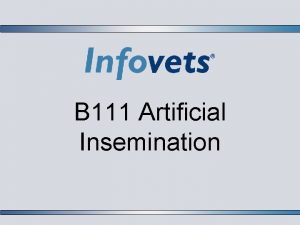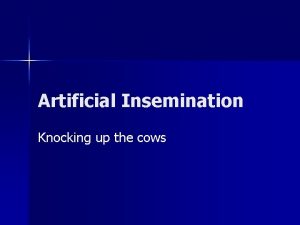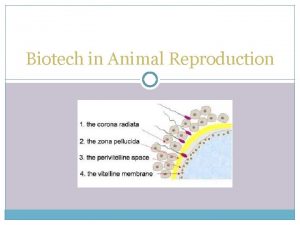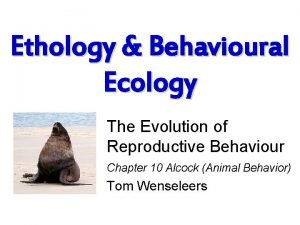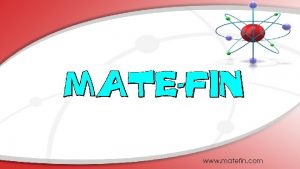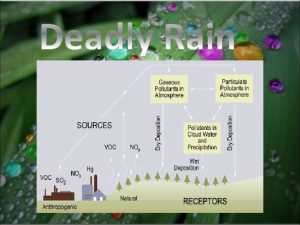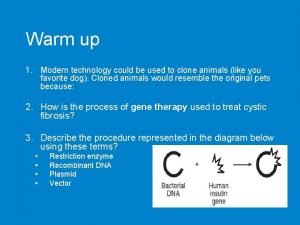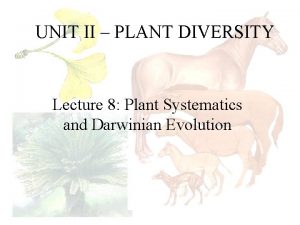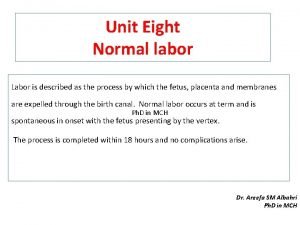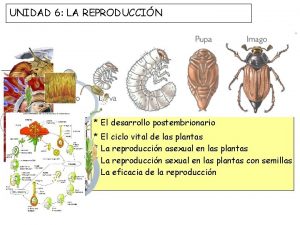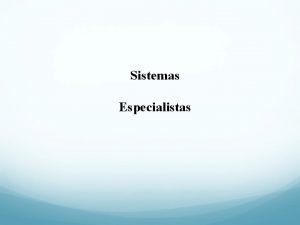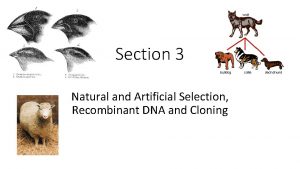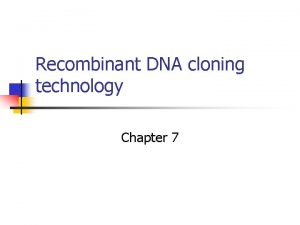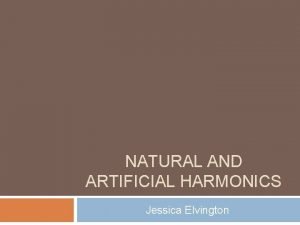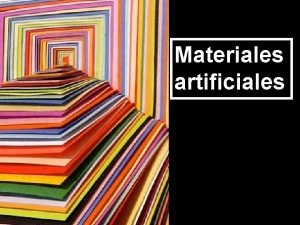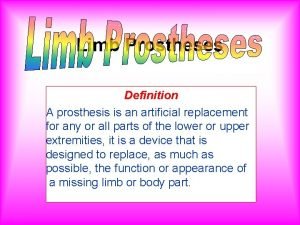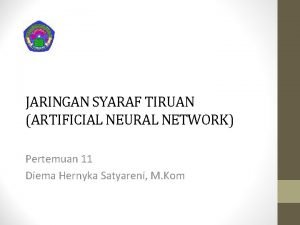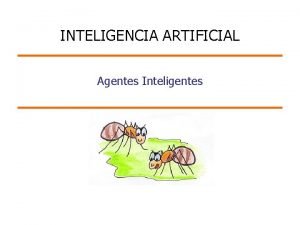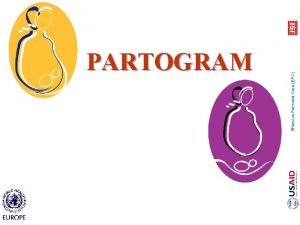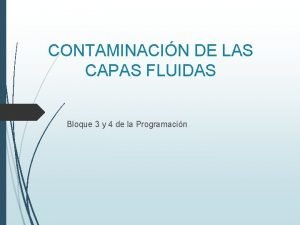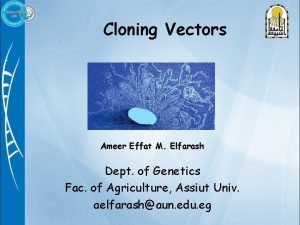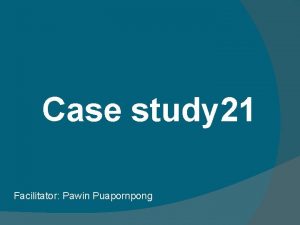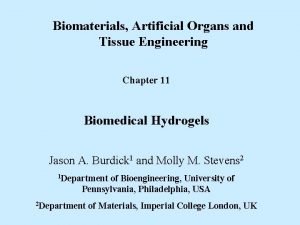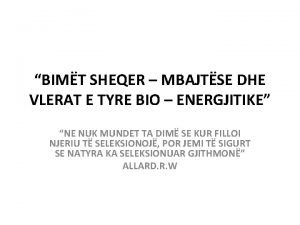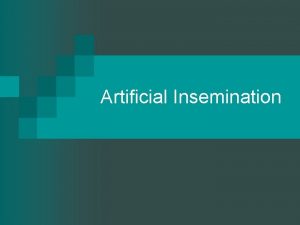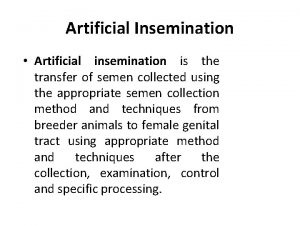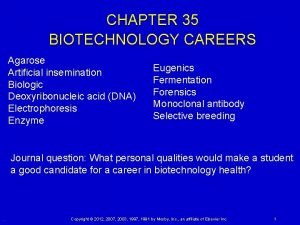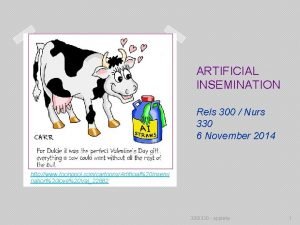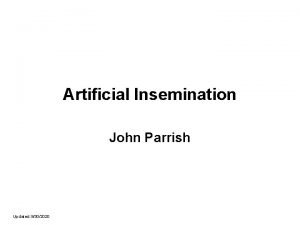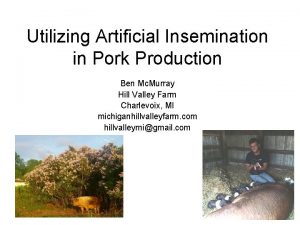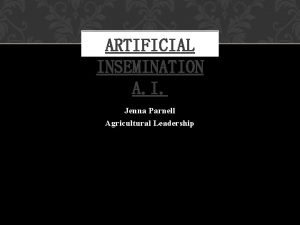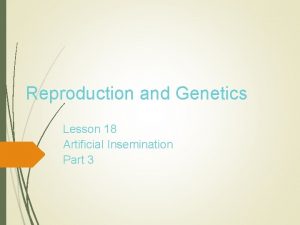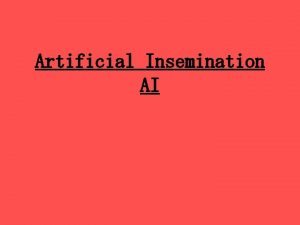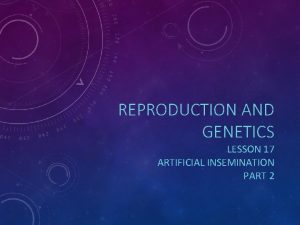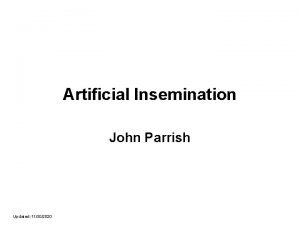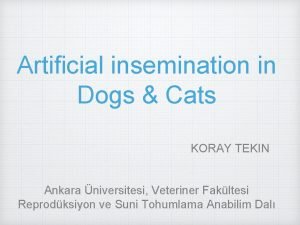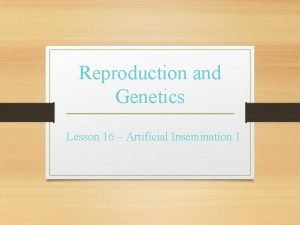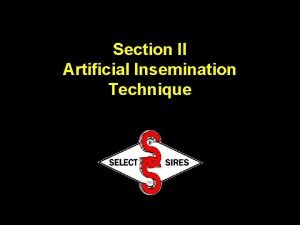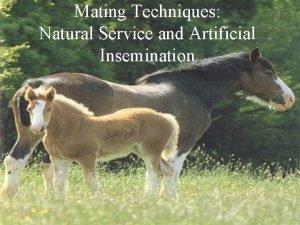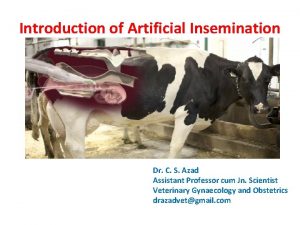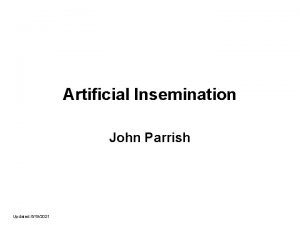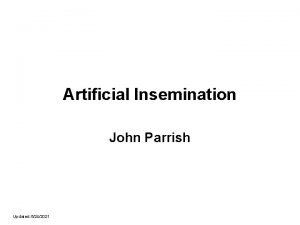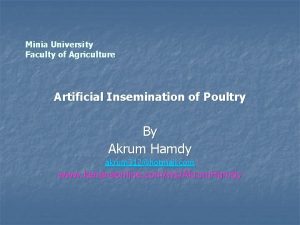ARTIFICIAL INSEMINATION SCHOOL CARLOS TELLEZ D V M



























































- Slides: 59

ARTIFICIAL INSEMINATION SCHOOL CARLOS TELLEZ D. V. M. ALTA GENETICS

Create Value ▲ Build Trust ▲ Deliver Results DEFINITION �� A. I is the instrumental technique used to deposit semen in to the body of the uterus of a female in estrus (heat), to obtain a pregnancy

ADVANTAGES �� 1. Genetic improvement: A. I allows us the use of genetically superior bulls. �� 2. Venereal disease transmission: Eliminates the risk of sexually transmitted diseases and improves the hygienic control. �� 3. Management: Natural service sires can be dangerous for both cows and people. �� 4. Economy: There is no need to work with herd bulls, saving the costs for feed, transport, housing and veterinary expense.

CONSIDERATIONS �� 1. Requires good management, a good nutrition program, effective herd health, accurate records. �� 2. Requires accurate heat detection and trained AI technicians. �� 3. Appropriate handling facilities.

REPRODUCTIVE ANATOMY OF THE COW Lumbar Vertebrae Sacral Vertebrae Coccygeal Vertebrae Rectum Body of uterus Vagina Ovary Vulva Cervix Infundibulum Oviduct Bladder Horn of uterus

REPRODUCTIVE ANATOMY OF THE COW �� Located on the pelvic floor just below the rectum. �� A. External genitals: Composed of the vulva, clitoris and vestibular glands. �� B. Vagina: It is a cavity that connects the vulva with the cervix. At natural service it receives the penis of the male.

REPRODUCTIVE ANATOMY OF THE COW Uterus: The main roll of the uterus is to feed, protect and offer shelter to the fetus until the calving moment. It consists of three parts: cervix, body of the uterus and two uterine horns.

REPRODUCTIVE ANATOMY OF THE COW Cervix: 1 to 5 inches long and 1 to 3 inches in diameter. It is made up of fibrous tissue, which is dense and hard to the palpation. Position of the cervix may vary with age of cow.

REPRODUCTIVE ANATOMY OF THE COW Body of the uterus: Located anterior to the cervix this structure is the place where the semen should be deposited (target site). It is made up of soft tissue and it is usually one (1) inch long.

REPRODUCTIVE ANATOMY OF THE COW Uterine Horns: Each one is approximately from 8 to 16 inches of length and they are connected to their respective oviducts.

REPRODUCTIVE ANATOMY OF THE COW �� Ovaries: Approximately 1. 5 inch in length, 1 inch in width and ½ inch in thickness. Their main function is to produce eggs and the secretion of hormones (estrogen and progesterone). �� Oviducts: Tubs that connect the ovaries with the uterine horns. It provides the site of encounter (fertilization) between the ovum and the sperm.

REPRODUCTIVE ANATOMY OF THE COW (OVARIES)

PHYSIOLOGY OF THE ESTRUS CYCLE

ESTRUS CYCLE �� The estrus cycle in dairy cattle is between 18 to 24 days, with an average of 21 days. �� The estrus cycle is divided in 4 phases: Estrus, Metestrus, Diestrus and Proestrus.

ESTRUS (HEAT) It is the period (12 to 18 hours) in which the cow is receptive to the bull. In this phase the Estradiol is released by the dominant follicle and its level is increased in the bloodstream causing the release of Gn. RH (gonadotropin releasing hormone) from the hypothalamus and a surge of LH (luteinizing hormone) is released from the anterior pituitary. It is in this moment when the cow begins showing the sings of estrus (heat). Ovulation occurs 12 to 16 hours after the end of the estrus (heat).

METESTRUS This stage lasts 4 days and begins after ovulation with the formation of a CL (corpus luteum). The action of the LH (luteinizing hormone) and Progesterone secreted by the corpus luteum, inhibits the FSH (follicle stimulating hormone) released by the pituitary gland. If pregnancy recognition occurs, the CL will continue to produce progesterone to maintain the pregnancy.

DIESTRUS This phase (12 to 13 days) is controlled by progesterone. A mature CL is established and if the cow is not pregnant, prostaglandin f 2ά will be released by the uterus on day 16 of the estrus cycle causing the regression of the CL.

PROESTRUS (4 to 5 days). After the regression of the CL a new surge of Gn. RH, FSH and LH is released by the hypothalamus and pituitary gland causing the growth of a dominant follicle necessary for the next behavioral estrus and posterior ovulation.

HORMONAL REGULATION Hormones Origin Function Gn. RH (Gonadotropin releasing Hormone). Hypothalamus Stimulation of the release of FSH and LH. FSH (Follicle-stimulating hormone). Pituitary gland Follicular growth and production. LH (Luteinizing hormone) Pituitary gland Final maturation of follicle, ovulation, CL formation. Estrogens Ovaries (Follicle) Growth of uterus, estrus behavior, cervical mucus secretion, release of LH for ovulation. Oxytocin Ovaries (corpus luteum, Pituitary) Milk excretion and prostaglandin synthesis. Prostaglandin F 2 a Uterus (endometrium) Lysis of corpus luteum Progesterone Ovaries (CL) Maintain the pregnancy.

SIGNS OF ESTRUS (HEAT) 1. Aggressive behavior (prior to estrus). 2. Attempts to mount other cows. 3. Smell vulva of other cows. 4. Swollen Vulva. 5. Rubbed off tail, muddy flanks. 6. Mucus (vulva). 7. STANDS TO BE MOUNTED

SIGNS OF ESTRUS

SIGNS OF ESTRUS

TAIL CHALK Tail chalk should be positioned starting two inched behind the pin bones to the tip of the tail head in a 3/4 inch thick stripe. Each cow should receive one stripe of chalk per day.

TAIL CHALK �� The objective is to make the chalk appear uniform so that even slight signs of estrus are noticeable. �� Improper chalking Will lead to false positives and missed heats.

ESTRUS SYNCHRONIZATION �� �� Ovsynch 10 Day Cosynch Heatsynch Presynch Resynch Prostaglandin Programs CIDR Programs MGA Programs

OVSYNCH �� �� Monday=Day 0 Monday=Day 7 Wednesday=Day 9 Thursday=Day 10 2 cc Gn. RH Pg. F 2 a 2 cc Gn. RH Timed AI

10 DAY COSYNCH �� Monday=Day 0 �� Monday=Day 7 �� Thursday=Day 10 2 cc Gn. RH Pg. F 2 a 2 cc Gn. RH and AI

HEAT-SYNCH �� �� �� Monday=Day 0 Monday=Day 7 Tuesday=Day 8 Wednesday=Day 9 Thursday=Day 10 2 cc Gn. RH Pg. F 2 a 0. 5 cc ECP AI all in Estrus AI all Remaining

STAGE OF CYCLE WHEN STARTED �� Cows started when having a dominant follicle perform better than those where a dominant follicle is not present �� Groups of cows serviced before 70 DIM do not perform as well as those serviced after 70 DIM when in a Synchronization Program

FOLLICULAR WAVES

PRESYNCH �� Pre-synchronization of Cows will allow a higher percentage of the cows to be in the most favorable stage of the Estrus Cycle when Synchronization is initiated �� Two injections of Pg. F 2 a are given 14 days apart and then the Synch Program is started 12 to 14 days after the 2 nd Pg. F 2 a

PRESYNCH-OVSYNCH-HEATSYNCH

RESYNCH �� Gn. RH given 7 days before Preg Check will allow open cows to be serviced within 2 to 3 days when vet check is the same as “shot” day �� Best performance is achieved when started on days 28 through 34 after last insemination

RESYNCH �� For those diagnosing pregnancy at 32 days or less, it is better to start the cows found open at the day of examination than it is to start them the week before �� Reason? Dominant Follicles

PROSTAGLANDINS (Pg. F 2 a) �� Pg. F 2 a works by causing luteolysis of the existing CL �� Estrus will follow injection in 2 to 7 days �� Injections repeated in 11 to 14 days will improve synchronization with most heats in 2 to 5 days

CIDR PROGRAMS �� �� Day Day 0 6 7 8 = = = – CIDR In Pg. F 2 a CIDR Out 10 = Estrus Detection and AI

MGA �� MGA fed at the rate of 0. 5 mg / head / day for 14 days �� Nineteen days later (day 33) = Pg. F 2 a �� Estrus Detection and AI 2 to 4 days after Pg. F 2 a (days 35 -37)

A. I EQUIPMENT Storage Tank 1. Clean and dry place. 2. Always carry it in vertical position. 3. Check nitrogen periodically

A. I EQUIPMENT �� Thaw unit �� A. I Gun �� Plastic sheath �� Palpation sleeves �� Tweezers �� Straw cutter or scissors �� Paper towels �� Lubricant

SEMEN HANDLING �� Wash hands prior to procedure. �� Prepare thaw unit with clean water 95 F �� Place thaw unit close to the tank �� Keep canister below frost line �� Use tweezers to transfer straw from the tank to the thaw unit. < 5 seconds. �� Straw should be thaw in 95 F water for a minimum of 40 seconds.

SEMEN HANDLING �� Once thawed, straws cannot be refrozen. �� Pre-warm AI gun. �� Dry straw completely with a paper towel. �� Protect the straw from temperature fluctuations at all times. �� Cut the sealed end of the straw squarely and cleanly. �� Place plug end of straw into the gun. �� Place a sheath over gun and secure firmly.

SEMEN HANDLING �� Advance semen to fill airspace in straw. �� Protect gun against temperature changes or contamination (gun warmer or shirt). �� Place semen into cow as soon as possible �� Prepare a maximum of 3 guns at a time.

A. I. TECHNIQUE Once you are sure that the cow to breed is not pregnant and is in heat, check the identification number and the breeding records.

A. I. TECHNIQUE Put on a shoulder length disposable plastic glove, lubricate it and stand sideways behind the cow. Form a cone with yours fingers, and gently insert the hand through the anal opening.

A. I. TECHNIQUE Once the hand is fully in the rectum, open fingers from the cone position and remove the fecal matter if needed. Avoid excessive motion of your arm because it causes air to rush in the rectum, which will not allow you to grasp the cervix.

A. I. TECHNIQUE Gently slide the hand from the upper part of the rectum to the lower part to identify the cervix. Hold the cervix having your thumb on the top and the rest of your fingers on the bottom.

A. I. TECHNIQUE Thoroughly wipe the vulva area with a clean paper towel. This helps to prevent the interior of the reproductive tract from becoming contaminated and possibly infected.

A. I. TECHNIQUE Insert the insemination gun through the vulva at a 40 to 45 degree angle until it touches the roof of the vagina. Level the insemination gun to go through the passageway to the cervix. This procedure avoids the possibility of entering the urethra located on the floor of the vagina

A. I. TECHNIQUE While passing the insemination instrument through the vagina, push the cervix forward with the hand holding the cervix. This will stretch the vagina wall eliminating the possibility of the insemination gun getting caught in a vaginal fold or the blind pouch around the enter of the cervix. At this point the tip of the gun can be guided to the cervical canal by the fingers of the hand holding the cervix.

BLIND POUCH Uterine Horn Ovary Dye Placed in blind Pouch Cervix Ovary Uterine Horn Insemination Gun Vagina Bladder

A. I. TECHNIQUE Once the tip of the insemination gun is in the cervical canal, maintain slight forward pressure on the rod while manipulating the cervix ahead of the gun. While you are passing the A. I. gun through the cervix keep your index finger at the end of the cervical canal, so you can feel the tip of the gun at the target site.

DEPOSIT SEMEN INTO THE BODY OF THE UTERUS Uterine Horn Vagina Ovary Dye Placed on target Cervix Ovary Uterine Horn Insemination gun

A. I. TECHNIQUE Lift finger and slowly deposit the semen (this maximizes the amount and equal distribution of semen on the uterine body) make sure you are on the target at all times. Depositing the semen in the cervix or in the uterine horns may result in lower pregnancy rates, and sometimes it may cause damage to the uterus.

A. I. TECHNIQUE After all semen is deposited, withdraw the A. I. gun and your arm, release the sheath and the straw from the A. I. gun. Then peel your glove hand over them and dispose the package in a proper trash container. Clean your hands and complete the breeding record immediately after each insemination. Daily clean your equipment with a paper towel wet with alcohol. Clean your footwear before leaving the A. I area.

KEY PERFORMANCE INDICATORS (KPI) Palpated Pregnancy Rate (PPR) is an indirect measure of estrus detection efficiency and is calculated by dividing the number of cows found pregnant at pregnancy examination by the number of cows examined. 25 pregnant and 50 examined = PPR of 25/50 or 50%. Extremely aggressive breeding decisions may lead to a high PPR but a lower Conception Rate (CR) because of a decline in estrus detection accuracy, servicing animals that are not truly in estrus. Strive for a PPR that is >65%.

KPI Conception Rate (CR) is defined as the percent of animals that become pregnant to a single service. If 100 animals are serviced and 35 become pregnant the CR = 35/100 or 35%. Strive for a CR >35%.

KPI Service Rate (SR) is the percent of eligible animals serviced in a 21 day period. An eligible animal is one that is past her voluntary wait period (VWP) and not pregnant. If there are 100 eligible animals and 65 are serviced in a 21 day period the SR = 65/100 or 65%. Strive for a SR of >65%.

KPI Pregnancy Rate (PR) is the percent of eligible animals that become pregnant in a 21 day period. An estimation of PR can be made by multiplying the CR by SR. If CR = 30% and SR = 60% then PR will be ~ 18%, (. 3 x. 6 =. 18). Strive for a PR of >22%.

KPI Hard Count Pregnancy creation can be measured as a percent of the adult milking herd made pregnant per time period. 10% of the milking herd made pregnant per month is an admirable goal. Few herds achieve this number; many herds will achieve 9% made pregnant per month. 10% per month is the same as 2. 3% per week, 9% per month is the same as 2. 1% per week. Strive for >9% per month. As the number of eligible cows will vary per time period, this KPI should be looked at evaluated over a reasonable period of time.
 Advantages and disadvantages of artificial insemination
Advantages and disadvantages of artificial insemination Cow artificial insemination
Cow artificial insemination Artificial insemination biotechnology
Artificial insemination biotechnology Víctor alfonso téllez rizcala
Víctor alfonso téllez rizcala Catalina tellez posada
Catalina tellez posada Traumatic insemination
Traumatic insemination Cysterelin
Cysterelin Natural and artificial radioactivity
Natural and artificial radioactivity Chemical reaction of acid rain
Chemical reaction of acid rain Why is artificial selection used
Why is artificial selection used Xoon in artificial intelligence
Xoon in artificial intelligence What is an example of artificial selection
What is an example of artificial selection Vasten sign
Vasten sign Artificial transmutation worksheet
Artificial transmutation worksheet Metamorfosis simple
Metamorfosis simple Inteligencia artificial sistemas expertos
Inteligencia artificial sistemas expertos Similarities
Similarities State space artificial intelligence
State space artificial intelligence Sistema especialista inteligencia artificial
Sistema especialista inteligencia artificial Curve of spee and wilson
Curve of spee and wilson Transgenic organisms examples
Transgenic organisms examples Searching for solutions in artificial intelligence
Searching for solutions in artificial intelligence 15-780 graduate artificial intelligence
15-780 graduate artificial intelligence Knowledge manipulation in ai
Knowledge manipulation in ai Yeast artificial chromosome
Yeast artificial chromosome Types of knowledge in ai
Types of knowledge in ai Genetics
Genetics Natural and artificial radioactivity
Natural and artificial radioactivity Artificial speciation
Artificial speciation Natural selection vs artificial selection
Natural selection vs artificial selection Seagull effect cello
Seagull effect cello Difference between continuous and discontinuous variation
Difference between continuous and discontinuous variation Vandelay art. seinfeld the show about nothing. penguin 1997
Vandelay art. seinfeld the show about nothing. penguin 1997 Example of sexual selection
Example of sexual selection Materiales artificiales papel
Materiales artificiales papel Artificial limbs
Artificial limbs Artificial intelligence leadership
Artificial intelligence leadership Artificial intelligence assessment
Artificial intelligence assessment Math and artificial intelligence
Math and artificial intelligence Pengertian artificial neural network
Pengertian artificial neural network Peas for interactive english tutor
Peas for interactive english tutor Representación del conocimiento inteligencia artificial
Representación del conocimiento inteligencia artificial Agentes de reflejo simple
Agentes de reflejo simple 15-780 graduate artificial intelligence
15-780 graduate artificial intelligence Difference between innate and learned behavior
Difference between innate and learned behavior Analogizers
Analogizers A fuzzy proposition
A fuzzy proposition Partogram examples
Partogram examples Rind gall in timber
Rind gall in timber Cse 571 asu
Cse 571 asu Contaminacion atmosferica artificial
Contaminacion atmosferica artificial 15-780 graduate artificial intelligence
15-780 graduate artificial intelligence Yeast artificial chromosome
Yeast artificial chromosome Informed and uninformed search
Informed and uninformed search Natural selection vs artificial selection
Natural selection vs artificial selection Artificial rupture of membranes
Artificial rupture of membranes Artificial construction materials
Artificial construction materials Biomaterials artificial organs and tissue engineering
Biomaterials artificial organs and tissue engineering Seleksionimi artificial
Seleksionimi artificial Canine relationship
Canine relationship
